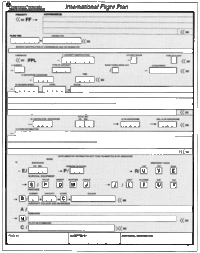User:Johan G/ICAO flight plans and flight plan messages
The ICAO flight plan format is used for all international flights, VFR and IFR, and most domestic IFR flights around the world. The flight plan is serialised into text strings that are handled as messages by the various ATS organisations. There are also other messages for activation, changing and termination of flight plans etc.
Note: The flight plan format was changed and more fields and data was added 15 November 2012.
The flight plan form
The filled in flight plan form, formally the "initial flight plan", is built up of a number of data fields, called items when discussing flight plan form, containing various information.
First off only upper case A..Z characters and the numbers 0..1 are allowed, no spaces, punctuation, dashes etc. The fields are separated by dashes and some of them begin on a new line.
At first it might seems strange that the fields are not numbered in sequential order, but the reason for this is the the fields used in the flight plan message is only a pick of a larger number of fields that are not relevant when filing a flight plan and because a few fields are deprecated and no longer in use.
<sample flight plan>
Items 3-18 - Flight plan
Item 3 - Message type
(FPL...
Message type, which is logically /FPL when filing a flight plan.
Item 7 - Aircraft identification
...-SK2592...
Aircraft registration or a flight number and should be 2-7 alphanumerical characters. In case of being a flight number the tail number should be added after a /REG to field 18.
Item 8 - Flight rules and type of flight
...-IS ...
Flight rules and type of flight. The flight rules are coded as below:
- I: Entire flight by IFR
- V: Entire flight by VFR
- Z: The flight begins by IFR
- Y: The flight begins by VFR
Type of flight is coded as below:
- S: Scheduled flight
- N: Unscheduled air transport
- G: General aviation
- M: Military flight (i.e. training and ferry flights)
- X: Other flights
Item 9 - Number, type and wake turbulence category
... -B737/M...
Number of aircraft (2-99), if more than one, type of aircraft and wake turbulence category.
The type of aircraft and wake turbulence category should be as per ICAO DOC 8643 - Aircraft Type Designators. If the aircraft type can not be found "ZZZZ" should be used and the full designation shall be added to field 18 after a /TYP tag. If the wake turbulence category can not be found, use category as per below:
- Wake turbulence categories:
- L: Light (MTOW < 7,000 kg or 15,000 lb)
- M: Medium (7,000 < MTOW < 136,000 kg or 300,000 lb)
- H: Heavy (MTOW > 136,000 kg)
- J: Jumbo (extremely heavy, i.e. A380)
- US wake turbulence categories:
- L: Small (MTOW < 41,000 lb or 19,000 kg)
- M: Large (41,000 lb < MTOW < 300,000 lb or 140,000 kg)
- H: Heavy (MTOW > 300,000 lb)
- Not available: Super (extremely heavy, i.e. A380)
Item 10 - Equipment
...-<sample>...
Item 13 - Departure
... -<sample> ...
Item 15 - Route
... -<sample> ...
Item 16 - Arrival
... -<sample> ...
Item 18 - Other information
... -<sample>) ...
Item 19 - Supplementary information
... -<sample>)
Related content
External links
Flight plan form basics
- ICAO Flightplan Form Basics (PDF), EuroFPL, Eurocontrol.
